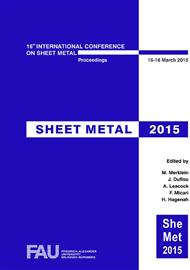p.41
p.49
p.57
p.65
p.71
p.77
p.83
p.91
p.99
Laser Forming of Steel Dome-Shaped Parts Using a Flower Pattern
Abstract:
In recent years, laser forming of round plates into bowl or dome shapes by use of circular, radial and circular-radial patterns have been investigated. Usually formed circular plates using circular or linear patterns are distorted as asymmetric saddle shapes. In this study, a new flower pattern has been proposed to form round plates by laser. To make this pattern, the laser beam scans several petal paths on a circular blank. Laser forming of round plates by the proposed pattern have been studied by three dimensional finite element method. The results have been compared for the flower pattern and other conventional circular and radial pattern. In addition experiments have been conducted to verify the numerical results. The results show that the deformed parts by the petal path are more symmetrical in comparison with circular and radial patterns. It was found that in laser forming of dome-shaped parts, scanning by petal paths prevent distortion and increase the geometrical symmetry of deformed parts by laser. It was shown that laser radiation on petal paths improves the deformation process of laser forming of circular steel sheets.
Info:
Periodical:
Pages:
71-76
Citation:
Online since:
March 2015
Authors:
Keywords:
Price:
Сopyright:
© 2015 Trans Tech Publications Ltd. All Rights Reserved
Share:
Citation:


